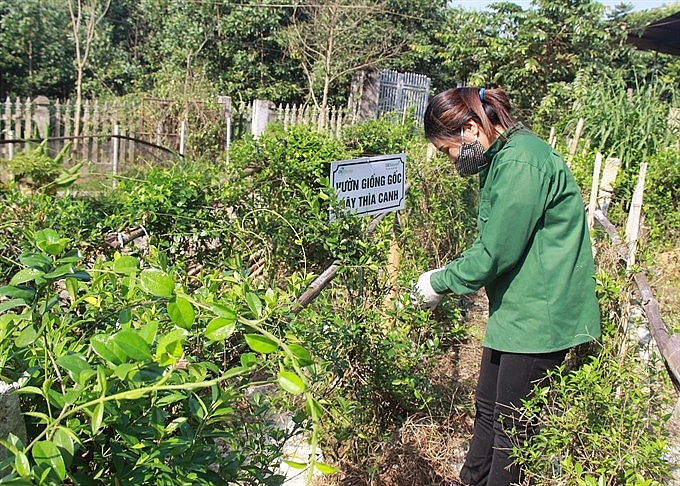Growing medicinal plants brings big profits
 |
| The 10ha herbal farm of DK Natural Product Company in Thái Nguyên Province brings profits of more than VNĐ200 million (US$8,800) per hectare to its farmers. – VNA/VNS Photo Hoàng Nguyên |
That year, a pharmaceutical company came to Nam Định to carry out a survey on land and water quality for constructing a clean and safe herbal medicine plantation. The company provided guidance for local farmers on how to cultivate the plant and pledged to buy all the products if the farmers could grow đinh lăng following standards.
Chung was among the farmers who were pioneers in implementing the cultivation.
“If you want to grow đinh lăng effectively, what you need is to choose land with high elevation, as the tree will die in flood, and you must keep the tree warm in cold weather,” he told Nam Định News online newspaper.
“The most important thing is to strictly follow the WHO guidelines on Good Agriculture and Collection Practices in growing the tree, from selecting seedlings, cultivating saplings, preparing land to taking care of the tree. It also requires regular inspection of tree quality. Any tree found to have disease must be chopped down to prevent it from spreading to others,” he said.
And Chung’s efforts have made good. With a total area of 3.7ha of land, Chung has grown 12,000 đinh lăng trees which has brought in an annual income of VNĐ200-300 million (US$8,800-13,300). He plans to harvest more than 200 tonnes of products this year.
“Growing đinh lăng also frees farmers from worrying about finding an output for their products. They only need to focus on growing the tree following company’s standard and the company will buy all qualified products, even for a higher price than the market price,” he said.
Hải Quang Commune now has around 40ha of đinh lăng.
The commune is just one among many other areas across the country that have successfully developed business-farmer co-operation models for growing clean and safe medicinal plant species, which helps to bring about hundreds of Vietnamese đồng of income for farmers.
Trần Thị Hồng Phương from the Traditional Medicine & Pharmacy Management Agency said at a recent workshop that the potential for developing medicinal herbs in Việt Nam is great. Quảng Ninh, Hưng Yên, Hải Dương and Nam Định in the north and Nghệ An, Kon Tum and Lâm Đồng in the central region all are provinces with great advantages in developing medicinal plants.
Many provinces have gradually formed trademarked zones for growing materials for herbal medicine, such as global artichoke growth in Lào Cai Province, cinnamon in Yên BáiProvince, and đinh lăng and dây thìa canh (gymnema sylvestre) in Nam Định Province.
She stressed that farmers should be encouraged to grow medicinal plants because this can bring profits three to 10 times higher than rice cultivation. However, farmers need support in all phases of medicinal herb production, from production to harvesting, processing and distribution, she said.
According to the Institute of Medicinal Materials, Việt Nam has 5,117 herbal plants and fungus, along with 408 species of animals and minerals used as materials for nearly 1,300 traditional remedies. Domestic demand for herbal medicinal materials is about 60,000-80,000 tonnes per year, mostly for producing foods, medicines and cosmetics.
To promote herbal medicine, experts at a conference last week pointed to the need to promote the value of good plants and apply advanced technologies for the development of herbal medicines from the selection of seedlings to product underwriting and distribution following the value chain.
What the stars mean:
★ Poor ★ ★ Promising ★★★ Good ★★★★ Very good ★★★★★ Exceptional
Related Contents
Latest News
More News
- Protect what’s next: towards a future free from meningococcal group B disease (December 05, 2025 | 18:00)
- New ILO report offers policy recommendations for disability inclusion (December 04, 2025 | 15:18)
- Maternal job loss may affect children’s mental health, research shows (December 03, 2025 | 19:11)
- Women lead Vietnam’s shift to climate-resilient agriculture (December 03, 2025 | 19:10)
- Experts highlight unpaid care work as key barrier to gender equality (December 03, 2025 | 15:15)
- Opportunities and inequalities for women workers in Vietnam's garment industry (December 03, 2025 | 09:00)
- Vietjet flights carry love to devastated central region (November 28, 2025 | 11:35)
- New initiative to boost the fight against domestic violence (November 26, 2025 | 10:00)
- South Korea funds IOM relief for Vietnam’s typhoon-affected communities (November 24, 2025 | 15:33)
- AI and human-centred values set to shape the future of HR in Vietnam (November 21, 2025 | 18:04)

 Tag:
Tag:

















 Mobile Version
Mobile Version